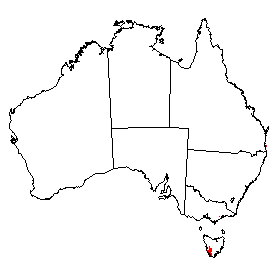Organosols [OR]
Concept
This class caters for most soils dominated by organic materials. Although they are found from the wet tropics to the alpine regions, areas are mostly small except in south west Tasmania. There have been few previous attempts to subdivide these soils and data are limited in Australia.

Distribution of Organosols in Australia.
Soil Profile (View type example photo
of Hemic Organosol).
Definition
Soils that are not regularly inundated by saline tidal waters and either:
- Have more than 0.4 m of organic materials within the upper 0.8 m. The required thickness may either extend down from the surface or be taken cumulatively within the upper 0.8 m. or
- Have organic materials extending from the surface to a minimum depth of 0.1 m; these either directly overlie rock or other hard layers, partially weathered or decomposed rock or saprolite, or overlie fragmental material such as gravel, cobbles or stones in which the interstices are filled or partially filled with organic material. In some soils there may be layers of humose and/or melacic horizon material underlying the organic materials and overlying the substrate.
Comment
The above definition is similar to definitions of organic soils in Soil Taxonomy (1975) and in Canada (Canada Soil Survey Committee 1978).
Suborders
- Soils in which the organic materials are dominated (about 75% by volume) by fibric peat. Fibric [BW]
- Soils in which the organic materials are dominated by hemic peat. Hemic [CE]
- Soils in which the organic materials are dominated by sapric peat. Sapric [EH]
Comment
These suborders are essentially the same as in Soil Taxonomy. The terms fibric, hemic and sapric correspond to fibrous, mesic (semifibrous) and humic as used in Canada and England and Wales. In some north Queensland seasonal swamps, thick peats can have 0.3-0.4 m of sapric over hemic and/or fibric peat. When more data are available it may be necessary to modify the suborder definitions to cater for soils where the type of peat changes with depth.
Great Groups
It is likely that not all of the great groups below will be applicable to each suborder. It is also likely that other great groups will be required as knowledge increases.
- Soils that are more or less freely drained and are never saturated for more than several days unless rain is falling and contain organic materials which occur as in Definition (ii) of Organosols. Folic [IF]
- Soils in which sulfuric materials occur within the upper 1.5 m of the profile. Sulfuric [EV]
- Soils in which sulfidic materials occur within the upper 1.5 m of the profile. Sulfidic [EU]
- Soils in which the major part of the organic materials is calcareous. Calcareous [BC]
- Soils in which the major part of the organic materials is not calcareous but is not strongly acid. Basic [AR]
- Soils in which the major part of the organic materials is strongly acid. Acidic [AI]
Subgroups
The following subgroups may not be relevant to all great groups of each suborder, and future investigations may reveal additional subgroups.
- Soils in which the organic materials directly overlie hard rock. Lithic [CZ]
- Soils in which the organic materials directly overlie partially weathered or decomposed rock or saprolite. Paralithic [DU]
- Soils with a marl layer either within or immediately below the section containing the organic materials. Marly [DD]
- Soils in which the organic materials directly overlie fragmental material such as gravel, cobbles or stones in which the interstices are filled or partially filled with organic material. Rudaceous [HD]
- Soils in which layers of humose and/or melacic horizon material underlie the organic materials and overlie the substrate. Modic [IJ]
- Soils with a thin ironpan below the organic materials. Placic [EC]
- Soils in which the organic materials show evidence of burnt peat (often in the form of coloured ash layers) within 0.8m of the surface. Ashy [HZ]
- Soils with a layer (or layers) of unconsolidated mineral material within or below the organic materials but within 0.8 m of the surface. Terric [FS]
- Other soils with a layer (or layers) of unconsolidated mineral material which occurs below 0.8 m of the surface. Regolithic [GF]
Possible Family Criteria
Nature of uppermost organic materials
The term granular [P] is applied if there is a surface layer at least 0.2 m thick which has a distinct granular or subangular blocky structure. This condition occurs in peat soils that have been either drained or drained and cultivated, and is also known as earthy or ripened peat. In Australia it is known to occur with sapric peats, but it is uncertain if it occurs with hemic or fibric peats.
Cumulative thickness of organic materials
| Very thin | [T]1 | : < 0.25 m |
|---|---|---|
| Thin | [U] | : 0.25 - < 0.5 m |
| Moderate | [V] | : 0.5 - < 1.0 m |
| Thick | [W] | : 1.0 - < 1.5 m |
| Very thick | [X] | : 1.5 - 5 m |
| Giant | [Y] | : > 5 m |
1 These codes are the same as those used for soil depth, which have the same class limits, in the other orders.